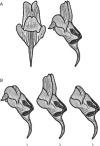Corolla herbivory, pollination success and fruit predation in complex flowers: an experimental study with Linaria lilacina (Scrophulariaceae)
- PMID: 17204536
- PMCID: PMC2803005
- DOI: 10.1093/aob/mcl267
Corolla herbivory, pollination success and fruit predation in complex flowers: an experimental study with Linaria lilacina (Scrophulariaceae)
Abstract
Background and aims: Herbivory on floral structures has been postulated to influence the evolution of floral traits in some plant species, and may also be an important factor influencing the occurrence and outcome of subsequent biotic interactions related to floral display. In particular, corolla herbivory may affect structures differentially involved in flower selection by pollinators and fruit predators (specifically, those ovopositing in ovaries prior to fruit development); hence floral herbivores may influence the relationships between these mutualistic and antagonistic agents.
Methods: The effects of corolla herbivory in Linaria lilacina (Scrophulariaceae), a plant species with complex flowers, were considered in relation to plant interactions with pollinators and fruit predators. Tests were made as to whether experimentally created differences in flower structure (resembling those occurring naturally) may translate into differences in reproductive output in terms of fruit or seed production.
Key results: Flowers with modified corollas, particularly those with lower lips removed, were less likely to be selected by pollinators than control flowers, and were less likely to be successfully visited and pollinated. As a consequence, fruit production was also less likely in these modified flowers. However, none of the experimental treatments affected the likelihood of visitation by fruit predators.
Conclusions: Since floral herbivory may affect pollinator visitation rates and reduce seed production, differences among plants in the proportion of flowers affected by herbivory and in the intensity of the damage inflicted on affected flowers may result in different opportunities for reproduction for plants in different seasons.
Figures




Similar articles
-
Interaction frequency and per-interaction effects as predictors of total effects in plant-pollinator mutualisms: a case study with the self-incompatible herb Linaria lilacina.Oecologia. 2012 Jan;168(1):153-65. doi: 10.1007/s00442-011-2084-z. Epub 2011 Jul 26. Oecologia. 2012. PMID: 21789530
-
Herbivory Increases Fruit Set in Silene latifolia: A Consequence of Induced Pollinator-Attracting Floral Volatiles?J Chem Ecol. 2015 Jul;41(7):622-30. doi: 10.1007/s10886-015-0597-3. Epub 2015 Jun 18. J Chem Ecol. 2015. PMID: 26085479
-
Pollination ecology of Silene acutifolia (Caryophyllaceae): floral traits variation and pollinator attraction.Ann Bot. 2006 Feb;97(2):289-97. doi: 10.1093/aob/mcj032. Epub 2005 Dec 12. Ann Bot. 2006. PMID: 16344265 Free PMC article.
-
Lingering Effects of Herbivory and Plant Defenses on Pollinators.Curr Biol. 2018 Oct 8;28(19):R1164-R1169. doi: 10.1016/j.cub.2018.08.010. Curr Biol. 2018. PMID: 30300606 Review.
-
Mechanisms and evolution of deceptive pollination in orchids.Biol Rev Camb Philos Soc. 2006 May;81(2):219-35. doi: 10.1017/S1464793105006986. Biol Rev Camb Philos Soc. 2006. PMID: 16677433 Review.
Cited by
-
Influence of green leaf herbivory by Manduca sexta on floral volatile emission by Nicotiana suaveolens.Plant Physiol. 2008 Apr;146(4):1996-2007. doi: 10.1104/pp.107.112326. Epub 2008 Feb 15. Plant Physiol. 2008. PMID: 18281418 Free PMC article.
-
Effects of Florivory on Floral Visitors and Reproductive Success of Sagittaria lancifolia (Alismataceae) in a Mexican Wetland.Plants (Basel). 2024 Feb 17;13(4):547. doi: 10.3390/plants13040547. Plants (Basel). 2024. PMID: 38498564 Free PMC article.
-
Interaction frequency and per-interaction effects as predictors of total effects in plant-pollinator mutualisms: a case study with the self-incompatible herb Linaria lilacina.Oecologia. 2012 Jan;168(1):153-65. doi: 10.1007/s00442-011-2084-z. Epub 2011 Jul 26. Oecologia. 2012. PMID: 21789530
-
The good, the bad and the flexible: plant interactions with pollinators and herbivores over space and time are moderated by plant compensatory responses.Ann Bot. 2011 Sep;108(4):749-63. doi: 10.1093/aob/mcr152. Epub 2011 Jul 1. Ann Bot. 2011. PMID: 21724655 Free PMC article.
-
Florivory and pollinator visitation: a cautionary tale.AoB Plants. 2016 Jul 11;8:plw036. doi: 10.1093/aobpla/plw036. Print 2016. AoB Plants. 2016. PMID: 27178063 Free PMC article.
References
-
- Aigner PA. Optimality modelling and fitness trade-offs: when should plants become pollinator specialists? Oikos. 2001;95:177–184.
-
- Andersson S, Widen B. Pollinator-mediated selection on floral traits in a synthetic population of Senecio integrifolius (Asteraceae) Oikos. 1993;66:72–79.
-
- Breadmore KN, Kirk WDJ. Factors affecting floral herbivory in a limestone grassland. Acta Oecologica. 1998;19:501–506.
-
- Campbell DR, Waser NM, Price MV, Lynch EA, Mitchell RJ. Components of phenotypic selection: pollen export and flower corolla width in. Ipomopsis aggregata. Evolution. 1991;45:1458–1467. - PubMed
-
- Cariveau D, Irwin RE, Brody AK, Sevillano García-Mayeya L, Ohe A. Direct and indirect effects of pollinators and seed predators to selection on plant and floral traits. Oikos. 2004;104:15–26.
Publication types
MeSH terms
LinkOut - more resources
Full Text Sources
Research Materials

